The Friulian Dolomites have been part of the UNESCO Dolomites since 2009, and constitute one of the wildest natural parks to be found in the area. They are characterized by a very distinctive structure: a long series of sharp spires, narrow valleys, and rock pinnacles.
The most famous of these rock structures is the Val Montanaia steeple, known as the Stone Cry. Only here do you encounter a few hikers, while the rest of the way is very wild and uncrowded. This area is almost totally alien to foreign tourism, it is forgotten in the shadow of the better-known Dolomites. Yet it has a charm and beauty that is unlike the rest of the DolomitesWhile the trail is fairly short, it packs a punch with 3300 m in 38 kilometers. The Friuluan Dolomites don’t mess around!














